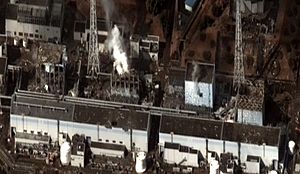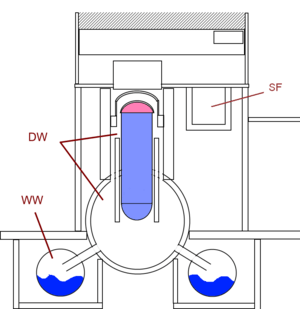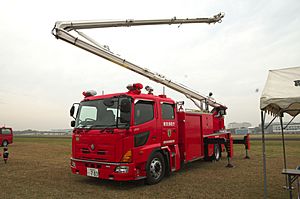Fukushima Daiichi Nuclear Power Plant facts for kids
The Fukushima Daiichi Nuclear Power Plant (also known as Fukushima I) is a nuclear power plant located in Ōkuma, Fukushima Prefecture, Japan. It was the first nuclear power plant built and operated solely by the Tokyo Electric Power Company (TEPCO).
In March 2011, serious nuclear emergencies happened at this power plant and other Japanese nuclear sites. These events made people question the safety and future of nuclear power. After the Fukushima nuclear disaster, the International Energy Agency cut its prediction for new nuclear power plants by half for the period up to 2035. The plant is now shut down.
Contents
Understanding the Nuclear Reactors
The nuclear reactors at Fukushima Daiichi were built by different companies. General Electric supplied units 1, 2, and 6. Toshiba supplied units 3 and 5, and Hitachi supplied unit 4. The company Ebasco designed the buildings for the General Electric units. All the construction work was done by Kajima.
Since September 2010, Unit 3 used a special type of fuel called mixed-oxide (MOX) fuel. Most of the units (1-5) had a "Mark 1" type of containment structure, which looks a bit like a light bulb. Unit 6 had a "Mark 2" type.
Unit 1 was a 439-megawatt (MW) boiling water reactor (BWR3). It was built in July 1967 and started making electricity on March 26, 1971. It was supposed to close down in March 2011. However, it was badly damaged during the 2011 Sendai earthquake and tsunami.
When Unit 1 was built, it had high safety levels for earthquakes. But by 2011, it was old and not as up-to-date as newer plants. No one expected such a strong earthquake to hit Japan.
| Unit | Type | Started working | Power generated | Reactor supplier | Designed by | Built by |
|---|---|---|---|---|---|---|
| Fukushima I – 1 | BWR-3 | October 1970 | 460 MW | General Electric | Ebasco | Kajima |
| Fukushima I – 2 | BWR-4 | July 18, 1974 | 784 MW | General Electric | Ebasco | Kajima |
| Fukushima I – 3 | BWR-4 | March 27, 1976 | 784 MW | Toshiba | Toshiba | Kajima |
| Fukushima I – 4 | BWR-4 | October 12, 1978 | 784 MW | Hitachi | Hitachi | Kajima |
| Fukushima I – 5 | BWR-4 | April 18, 1978 | 784 MW | Toshiba | Toshiba | Kajima |
| Fukushima I – 6 | BWR-5 | October 24, 1979 | 1,100 MW | General Electric | Ebasco | Kajima |
The 2011 Fukushima Nuclear Disaster
In March 2011, a powerful earthquake and tsunami hit Japan. Soon after, the Japanese government told people to leave the area around the Fukushima I plant. They also declared a local emergency. Experts worried about a meltdown at Unit 1. The next day, a government official said a partial meltdown at Unit 3 was "highly possible."
Units 1, 2, and 3 had automatically shut down because of the earthquake. Units 4, 5, and 6 were already shut down for maintenance. The plant's back-up generators, which provide power for cooling, were damaged by the tsunami. They started at first but stopped working after about an hour.
Japan's government declared a nuclear emergency because the cooling systems failed. Cooling is always needed to remove heat from a nuclear plant, even after it's shut down, due to ongoing atomic reactions. Hundreds of Japanese troops brought generators and batteries to the site to help.
Damage to Reactors and Generators
After the back-up diesel generators broke down, emergency batteries ran out after about eight hours. More batteries and mobile generators were brought in, but connecting them to power the water pumps was difficult. The usual connection points for the diesel generators were in a basement area that had been flooded by the tsunami.
Here's a summary of the damage reported on March 21, 2011:
| Status of reactors at 22:00 March 21 JST | 1 | 2 | 3 | 4 | 5 | 6 |
|---|---|---|---|---|---|---|
| Operating status at earthquake | In service | In service | In service | Outage (no fuel) | Outage (planned) | Outage (planned) |
| Fuel damage level | 70% damaged | 33% damaged | Damaged | Not damaged | Not damaged | Not damaged |
| Building damage level | Severely damaged by explosion | Slightly damaged by explosion | Severely damaged by explosion | Severely damaged by explosion | Vent holes drilled in roof | Vent holes drilled in roof |
| Pressure vessel, water level | Fuel exposed | Fuel exposed | Fuel exposed | Safe | Safe and shut down | Safe and shut down |
| Was seawater injected into reactor core | Continuing | Continuing | Continuing | Not necessary | Not necessary | Not necessary |
| Spent fuel damage level | Unknown, water injection considered | Unknown, seawater injected | Low water level, damage suspected | Low water level, damage suspected | Cooling recovered | Cooling recovered |
| Evacuation zone's radius | 20 km from the plant | |||||
| INES | Level 5 (estimated by Japanese and international agencies); some estimated Level 6 | |||||
Later, Unit 4 at the nearby Fukushima II Nuclear Power Station also shut down due to its safety systems. Even though outside power became available, the damage at the Fukushima Daiichi plant was very severe.
Long-Term Safety Plans
Using Boron
Officials considered using boric acid or other boron materials to help absorb neutrons in the spent fuel pools. Neutrons are tiny particles inside atoms. Boron helps stop nuclear reactions. France even sent 95 tons of boron to Japan in March 2011. Boric acid was put into the reactor cores, but it's not clear if it was also used when water was sprayed on the spent fuel pools.
A "Sarcophagus Tomb" and Liquid Metal
On March 18, 2011, a spokesman for Japan's nuclear agency was asked about burying the damaged reactors in a sand and concrete tomb, similar to what was done after the Chernobyl disaster. He said this idea was "in the back of our minds," but the main focus was on cooling the reactors first.
After the Chernobyl disaster, workers used sand and clay to cover the plant. However, these materials trapped heat inside. So, for Fukushima, experts thought about using a non-evaporating coolant, like a liquid metal, first. This would cool everything down. After that, a structure like the "sarcophagus tomb" built at Chernobyl could be considered.
Impacts of the Disaster
The nuclear emergencies at Fukushima Daiichi and other facilities made people around the world think differently about nuclear power. Many countries started to review the safety of their own nuclear reactors. The crisis also made people doubt how quickly new nuclear power plants would be built globally. The International Energy Agency cut its prediction for new nuclear power plants by half for the period up to 2035.
Media
Images for kids
-
Three of the reactors at Fukushima Daiichi overheated, causing meltdowns that eventually led to explosions, which released large amounts of radioactive material into the air.
-
Prime Minister Yoshihide Suga inspected the Daiichi Nuclear Power Plant on September 26, 2020
See also
 In Spanish: Central nuclear Fukushima I para niños
In Spanish: Central nuclear Fukushima I para niños













